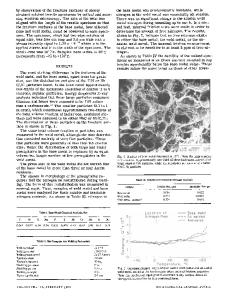Influence of Heat Treatment on the Sensitization of 18Cr-2Mo-Ti Stabilized Ferritic Stainless Steel
- PDF / 1,991,048 Bytes
- 7 Pages / 594 x 774 pts Page_size
- 35 Downloads / 301 Views
THE phenomenon of sensitization of ferritic stainless steels was first reported in 1933 by Houdrement and Shafmeister.m Since that time, relatively few investigations have been conducted on the sensitization of ferritic stainless steels compared to the vast number of papers published on the sensitization of austentic stainless steels. This apparent lack of interest in the sensitization behavior of ferritic stainless steels was due in large part to their limited usefulness as materials of construction. The use of ferritic stainless steels in structural components was chiefly restricted by their limited toughnss. In 1950, Binder and Spendelow2 demonstrated that the toughness of ferritic stainless steels could be greatly improved by the reduction of interstitials, carbon and nitrogen. The recent use of special melting practices, e.g., argon-oxygen decarburization (AOD), 3,4vacuum-oxygen decarurization (VOD), ~ and electron beam melting,4,7-9have made availble low interstitital ferritic stainless steels of excellent toughness. The application of ferritic stainless steels to structural components is no longer precluded by their low toughness and in many applications their use is now largely regulated by their corrosion resistance. Consequently, an understanding of the mechanism of sensitization of ferritic stainless steels is of some importance. In 1954, Lula, e t a l ~~ concluded that the intergranular corrosion susceptibility of 16-28 pct chromium ferritic stainless steels when rapidly cooled from above 927 ~ was due to the precipitation of grain boundary carbide or nitride phase. B~imel,n in 1963, suggested that the grain boundary chromium-depletion model of sensitization of austenitic stainless steels could also explain the sensitization of ferritic stainless steels, In 1969, Bond 12concluded that of all the various models of sensitization of ferritic stainless steels, only the grain boundary chromium depletion model could adequately T. M. DEVINE, Staff Scientist, Metallurgy Laboratory, A. M. RITTER, Associate Staff, Inorganic Materials and Structures Laboratory, and B. J. DRUMMOND, Associate Staff, Metallurgy Laboratory, are with Corporate Research and Development Center, General Electric Company, Schenectady, NY 12301. Manuscript submitted February 27, 1981. METALLURGICAL TRANSACTIONS A
explain his data obtained on 17 pct chromium-ferritic stainless steel. Similarly, Hodges ~a,~4in 1971 was able to use the grain boundary chromium depletion model to satisfactorily account for the influences of alloying effects and isothermal time-temperature effects on the sensitization behavior of ferritic stainless steel. Demo ~5 also used the grain boundary chromium depletion model to explain the intergranular corrosion behavior of 446 stainless steel. And in 1973, Frankenthal and Pickering~6 lent further credence to the grain boundary chromium depletion model of sensitization of ferritic stainless steels by demonstrating that preferential grain boundary corrosion only occurred over a limited potential range which was within th
Data Loading...










